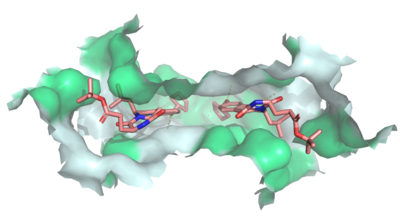Sandbox Reserved 1613
From Proteopedia
(Difference between revisions)
| Line 11: | Line 11: | ||
==Function== | ==Function== | ||
ABCG2 transports a variety of <scene name='83/832939/Mz29/1'>substrates</scene>, particularly flat, hydrophobic, and/or polycylic molecules. It is found in different biological membranes, such as the blood-brain barrier (BBB), blood-testis barrier, and the blood-placental barrier. It is thought to help protect those tissues and many others from cytotoxins. In addition to cytotoxin protection, ABCG2 secretes endogenous substrates in the adrenal gland, excretes toxins in the liver and kidneys, and regulates absorption of substrates. | ABCG2 transports a variety of <scene name='83/832939/Mz29/1'>substrates</scene>, particularly flat, hydrophobic, and/or polycylic molecules. It is found in different biological membranes, such as the blood-brain barrier (BBB), blood-testis barrier, and the blood-placental barrier. It is thought to help protect those tissues and many others from cytotoxins. In addition to cytotoxin protection, ABCG2 secretes endogenous substrates in the adrenal gland, excretes toxins in the liver and kidneys, and regulates absorption of substrates. | ||
| - | + | <ref name="Fetsch">PMID:15990223</ref> | |
== Disease == | == Disease == | ||
Multidrug resistant cancers are due to ABCG2 excreting cancer drugs out of the cell before they have the chance to kill the cell. Some of these cancers include breast, ovarian, and lung. | Multidrug resistant cancers are due to ABCG2 excreting cancer drugs out of the cell before they have the chance to kill the cell. Some of these cancers include breast, ovarian, and lung. | ||
| Line 21: | Line 21: | ||
Multidrug Transporter ABCG2 is a <scene name='83/832937/Dimer/1'>dimer</scene> that consists of two cavities seperated by a <scene name='83/832937/Leucine_plug/3'>leucine plug</scene>. Cavity 1 is a binding pocket open to the cytoplasm and the inner leaflet of the plasma membrane. Its shape is suitable to bind flat, hydrophobic and polycyclic substrates. Many of its amino acids residues form hydrophobic interactions with the bound substrate, as shown in green in '''Figure 1'''. Cavity 2 is located above the leucine plug. It is empty until a <scene name='83/832937/Atp_and_mg_bound_to_abcg2/3'>magnesium ion and ATP</scene> are bound to ABCG2. Its <scene name='83/832937/Cysteine_disulfide_bridges/4'>inter- and intra-disulfides</scene> (red is inter- and intra-molecular disulfides, purple is intra-molecular only) promote the release of the substrate from the cavity into the extracellular space. | Multidrug Transporter ABCG2 is a <scene name='83/832937/Dimer/1'>dimer</scene> that consists of two cavities seperated by a <scene name='83/832937/Leucine_plug/3'>leucine plug</scene>. Cavity 1 is a binding pocket open to the cytoplasm and the inner leaflet of the plasma membrane. Its shape is suitable to bind flat, hydrophobic and polycyclic substrates. Many of its amino acids residues form hydrophobic interactions with the bound substrate, as shown in green in '''Figure 1'''. Cavity 2 is located above the leucine plug. It is empty until a <scene name='83/832937/Atp_and_mg_bound_to_abcg2/3'>magnesium ion and ATP</scene> are bound to ABCG2. Its <scene name='83/832937/Cysteine_disulfide_bridges/4'>inter- and intra-disulfides</scene> (red is inter- and intra-molecular disulfides, purple is intra-molecular only) promote the release of the substrate from the cavity into the extracellular space. | ||
| - | + | <ref name=”Jackson”>PMID:29610494</ref> | |
| - | + | <ref name="Manolaridis">PMID:30405239</ref> | |
</StructureSection> | </StructureSection> | ||
==References== | ==References== | ||
| - | <ref name=”Jackson”>PMID:29610494</ref> | ||
| - | <ref name="Manolaridis">PMID:30405239</ref> | ||
<ref name="Taylor">PMID:28554189</ref> | <ref name="Taylor">PMID:28554189</ref> | ||
| - | <ref name="Fetsch">PMID:15990223</ref> | ||
<References/> | <References/> | ||
==Student Contributors== | ==Student Contributors== | ||
Revision as of 02:44, 21 April 2020
ABCG2 Transporter Protein
| |||||||||||
References
- ↑ Fetsch PA, Abati A, Litman T, Morisaki K, Honjo Y, Mittal K, Bates SE. Localization of the ABCG2 mitoxantrone resistance-associated protein in normal tissues. Cancer Lett. 2006 Apr 8;235(1):84-92. doi: 10.1016/j.canlet.2005.04.024. Epub, 2005 Jun 28. PMID:15990223 doi:http://dx.doi.org/10.1016/j.canlet.2005.04.024
- ↑ Jackson SM, Manolaridis I, Kowal J, Zechner M, Taylor NMI, Bause M, Bauer S, Bartholomaeus R, Bernhardt G, Koenig B, Buschauer A, Stahlberg H, Altmann KH, Locher KP. Structural basis of small-molecule inhibition of human multidrug transporter ABCG2. Nat Struct Mol Biol. 2018 Apr;25(4):333-340. doi: 10.1038/s41594-018-0049-1. Epub, 2018 Apr 2. PMID:29610494 doi:http://dx.doi.org/10.1038/s41594-018-0049-1
- ↑ Manolaridis I, Jackson SM, Taylor NMI, Kowal J, Stahlberg H, Locher KP. Cryo-EM structures of a human ABCG2 mutant trapped in ATP-bound and substrate-bound states. Nature. 2018 Nov;563(7731):426-430. doi: 10.1038/s41586-018-0680-3. Epub 2018 Nov, 7. PMID:30405239 doi:http://dx.doi.org/10.1038/s41586-018-0680-3
- ↑ Taylor NMI, Manolaridis I, Jackson SM, Kowal J, Stahlberg H, Locher KP. Structure of the human multidrug transporter ABCG2. Nature. 2017 Jun 22;546(7659):504-509. doi: 10.1038/nature22345. Epub 2017 May, 29. PMID:28554189 doi:http://dx.doi.org/10.1038/nature22345
Student Contributors
Shelby Skaggs, Samuel Sullivan, Jaelyn Voyles

